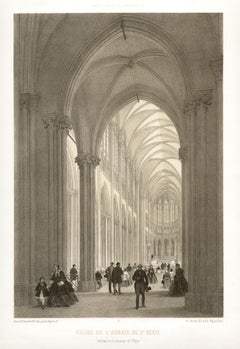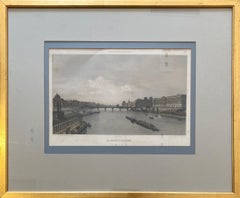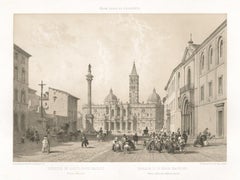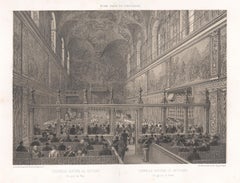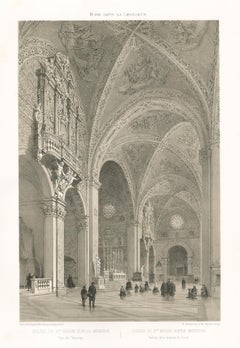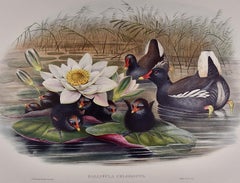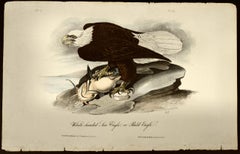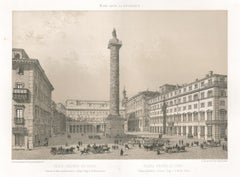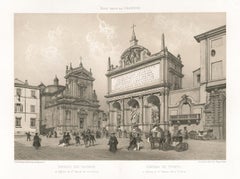Philippe Benoist Art
French, 1813-1905
Phillip Benoist was a painter, draftsman and lithographer, especially of landscapes and buildings. He was born in Geneva and worked in Paris where he was a pupil of Daguerre.
Philippe Benoist, one of the most coveted lithographers of the 19th century, specialized in topographical views. He was best known for his lithographic portfolio, including the album "Vues d'Italie et de Sicilie" with 40 lithographs, which was published by Bulla & Delarue in Paris in 1848, for which the present, delicately executed drawing served as a template. Benoist lived from 1813 to around 1880.
to
1
5
15
1
Overall Width
to
Overall Height
to
21
14
7
19
19
8
7
6
4
3
3
3
3
2
2
2
2
1
1
1
1
1
1
21
21
8,244
2,807
1,643
1,319
1
4
1
Artist: Philippe Benoist
Paris - Eglise de L'abbaye de St Denis, French lithograph, 1861
By Philippe Benoist
Located in Melbourne, Victoria
'Eglise de L'abbaye de St Denis', tinted lithograph by Felix Benoist (1818-1896).
From a series of lithographs depicting the famous buildings of Paris - 'Paris dans sa Splendeur', p...
Category
Late 19th Century Naturalistic Philippe Benoist Art
Materials
Lithograph
'Le Louvre et La Seine, ' by Phillipe Benoist, Four-color Lithograph
By Philippe Benoist
Located in Oklahoma City, OK
This is a beautiful four-color lithograph of the Louvre by the Seine by Philippe Benoist. It is double-matted in light blue with a gold tone wooden frame.
Phillip Benoist was a p...
Category
19th Century Academic Philippe Benoist Art
Materials
Lithograph
Paris : Stock Market Place - Original stone lithograph
By Philippe Benoist
Located in Paris, IDF
Philippe BENOIST
Paris : Stock Market Place - 1861
Original two tones stone lithographs
Printed name of the artist bottom right
On vellum 33.5 x 49 cm (c...
Category
1860s Realist Philippe Benoist Art
Materials
Lithograph
Basilica di St Maria Maggiore, Rome, Italy. Tinted lithograph, Philippe Benoist
By Philippe Benoist
Located in Melbourne, Victoria
'Basilica di St Maria Maggiore. Veduta della facciata principale'
Tinted lithograph by Philippe Benoist (1813-1881). From a French series titled 'Rome dans Sa Grandeur', circa 1870...
Category
Late 19th Century Victorian Philippe Benoist Art
Materials
Lithograph
Cistine Chapel, Vatican, Rome, Italy. Tinted lithograph by Philippe Benoist
By Philippe Benoist
Located in Melbourne, Victoria
'Cappella Sistina in Vaticano. Un giorno di Festa'
Tinted lithograph by Philippe Benoist (1813-1881). From a French series titled 'Rome dans Sa Gr...
Category
Late 19th Century Victorian Philippe Benoist Art
Materials
Lithograph
Chiesa di St Maria-Sopra-Minerva, Rome, Italy. Lithograph by Philippe Benoist
By Philippe Benoist
Located in Melbourne, Victoria
'Chiesa di St Maria-Sopra-Minerva. Veduta delle braccia di Croce'
Santa Maria sopra Minerva is one of the major churches of the Roman Catholic Order of Preachers (better known as t...
Category
Late 19th Century Victorian Philippe Benoist Art
Materials
Lithograph
Il Campidoglio (Capitoline Hill), Rome. Tinted lithograph, 1870
By Philippe Benoist
Located in Melbourne, Victoria
Tinted lithograph by Philippe Benoist (1813-1881) after Felix Benoist. Figures by Bayot.
From a French series titled 'Rome dans Sa Grandeur', circa...
Category
Late 19th Century Victorian Philippe Benoist Art
Materials
Lithograph
Loggia of Raphael, Vatican, Rome, Italy. Tinted lithograph by Philippe Benoist
By Philippe Benoist
Located in Melbourne, Victoria
'Loggia di Raffaello, in Vaticano'
Tinted lithograph by Philippe Benoist (1813-1881). From a French series titled 'Rome dans Sa Grandeur', circa 1870.
Benoist was one of France's...
Category
Late 19th Century Victorian Philippe Benoist Art
Materials
Lithograph
Porto di Ripetta, Rome, Italy. Lithograph
By Philippe Benoist
Located in Melbourne, Victoria
'Porto di Ripetta. Veduta presa dalla scala della Chiesa di S. Rocco'
Tinted lithograph by Philippe Benoist (1813-1881). Figures by Bayou. From a French series titled 'Rome dans Sa...
Category
Late 19th Century Victorian Philippe Benoist Art
Materials
Lithograph
Piazza e Basilica de Santi Apostoli, Rome, Italy. Lithograph, Philippe Benoist
By Philippe Benoist
Located in Melbourne, Victoria
'Piazza e Basilica de Santi Apostoli. Palazzi Odescalchi e Colonna'
Tinted lithograph by Philippe Benoist (1813-1881). From a French series titled 'Rome dans Sa Grandeur', circa 18...
Category
Late 19th Century Victorian Philippe Benoist Art
Materials
Lithograph
Basilica di San Paolo, Rome, Italy. Tinted lithograph, Philippe Benoist
By Philippe Benoist
Located in Melbourne, Victoria
'Basilica di San Paolo fuori delle mura'
Tinted lithograph by Philippe Benoist (1813-1881). From a French series titled 'Rome dans Sa Grandeur', circa 1870...
Category
Late 19th Century Victorian Philippe Benoist Art
Materials
Lithograph
Cortile del Palazzo di Venezia, Rome, Italy. Lithograph
By Philippe Benoist
Located in Melbourne, Victoria
'Cortile del Palazzo di Venezia, Colla Chiesa di San Marco'
Tinted lithograph by Eugene Ciceri after Felix Benoist. Figures by Bayot. From a French series titled 'Rome dans Sa Gran...
Category
Late 19th Century Victorian Philippe Benoist Art
Materials
Lithograph
Paris - Eglise Saint Genevieve (Ancien Pantheon), French lithograph, 1861
By Philippe Benoist
Located in Melbourne, Victoria
'Eglise St Genevieve', tinted lithograph by Felix Benoist (1818-1896).
From a series of lithographs depicting the famous buildings of Paris - 'Paris dans...
Category
Late 19th Century Naturalistic Philippe Benoist Art
Materials
Lithograph
Piazza di Monte Cavallo, Rome, Italy. Tinted lithograph by Philippe Benoist
By Philippe Benoist
Located in Melbourne, Victoria
'Piazza di Monte Cavallo e Palazzo pontificio del Quirinale'
Tinted lithograph by Philippe Benoist (1813-1881). From a French series titled 'Rome dans Sa Grandeur', circa 1870.
B...
Category
Late 19th Century Victorian Philippe Benoist Art
Materials
Lithograph
Galerie Chiaramonti, Vatican, Rome, Italy. Classical sculpture. Lithograph, 1870
By Philippe Benoist
Located in Melbourne, Victoria
'Musee du Vatican - Galerie Chiaramonti (Pie VII) avec l'entree de la Salle dite le Bras Nouveau'
Tinted lithograph by Philippe Benoist (1813-1881). Titled in French and Italian.
F...
Category
Late 19th Century Victorian Philippe Benoist Art
Materials
Lithograph
Paris - Fontaine de la Place du Chatelet, French lithograph, 1861
By Philippe Benoist
Located in Melbourne, Victoria
'Fontaine de la Place du Chatelet', tinted lithograph by Felix Benoist (1818-1896).
From a series of lithographs depicting the famous buildings of Paris -...
Category
Late 19th Century Naturalistic Philippe Benoist Art
Materials
Lithograph
Paris - Bibliotheque du Conservatoire des Arts et Metiers, lithograph, 1861
By Philippe Benoist
Located in Melbourne, Victoria
'Bibliotheque du Conservatoire des Arts et Metiers', tinted lithograph by Felix Benoist (1818-1896).
From a series of lithographs depicting the famous buildings of Paris - 'Paris da...
Category
Late 19th Century Naturalistic Philippe Benoist Art
Materials
Lithograph
Paris - Parc de Monceaux, French lithograph, 1861
By Philippe Benoist
Located in Melbourne, Victoria
'Parc de Monceaux', tinted lithograph by Felix Benoist (1818-1896).
From a series of lithographs depicting the famous buildings of Paris - 'Paris dans sa Splendeur', published in Na...
Category
Late 19th Century Naturalistic Philippe Benoist Art
Materials
Lithograph
Paris : Les Invalides under the Snow - Original stone lithograph
By Philippe Benoist
Located in Paris, IDF
Philippe BENOIST
Paris : Les Invalides Under the Snow - 1861
Original two tones stone lithographs
Printed name of the artist bottom right
On vellum 33.5...
Category
1860s Realist Philippe Benoist Art
Materials
Lithograph
Paris : Saint Paul and Saint Louis Church - Original stone lithograph
By Philippe Benoist
Located in Paris, IDF
Philippe BENOIST
Paris : Saint Paul and Saint Louis Church - 1861
Original two tones stone lithographs
Printed name of the artist bottom right
On vellum 33.5 x 49 cm (c. 13 x 20 inc...
Category
1860s Realist Philippe Benoist Art
Materials
Lithograph
Paris : The Column with an Angel on Bastille Square - Original stone lithograph
By Philippe Benoist
Located in Paris, IDF
Philippe BENOIST
Paris : The Column with an Angel on Bastille Square - 1861
Original two tones stone lithographs
Printed name of the artist bottom right
On vellum 33.5 x 49 cm (c. 1...
Category
1860s Realist Philippe Benoist Art
Materials
Lithograph
Related Items
A Family of Moorhens & Lilly Pad: A 19th C. Hand-colored Lithograph by Gould
By John Gould and Henry Constantine Richter
Located in Alamo, CA
This is an original 19th century hand-colored folio-sized lithograph entitled "Gallinula Chloropus" (Moorhen) by John Gould, published in his "Birds of Great Britain", published in London between 1862 and 1873. The print, which was drawn by Gould and Henry Richter and lithographed by Walter & Cohn, depicts a family of Moorhens, including two adults and six babies in a beautiful landscape. The adults are in the water and the babies are lying on the leaves a flowering lilly pad.
This striking Gould hand-colored moorhen family lithograph is augmented with gum-arabic paint. The sheet measures 14.88" high and 21.75" wide. It is in excellent condition, other than a spot in the upper portion of the right margin and two small spots at the edge of the lower margin on the left. The original descriptive text pages from Gould's 19th century publication are included.
There are several other unframed Gould hummingbird lithographs available on our 1stdibs and InCollect storefronts. Two or more of these striking lithographs would make an attractive display grouping. A discount is available for purchase of a set depending on the number. These additional Gould hummingbirds may be viewed by typing Timeless Intaglio...
Category
Mid-19th Century Naturalistic Philippe Benoist Art
Materials
Lithograph
"Bald Eagle", an Original Audubon Hand-colored First Edition Lithograph
By After John James Audubon
Located in Alamo, CA
An original rare and extremely collectible first octavo edition John James Audubon hand-colored royal octavo lithograph entitled "White-headed Sea Eagle or Bald Eagle", No. 3, Plate ...
Category
Mid-19th Century Naturalistic Philippe Benoist Art
Materials
Lithograph
Forest Triptych, Looking Up Through The Trees, Blue Nature, Handmade Cyanotype
By Kind of Cyan
Located in Barcelona, ES
This series of cyanotype triptychs showcases the beauty of nature scenes, including stunning beaches and oceans, as well as the intricate textures of w...
Category
2010s Naturalistic Philippe Benoist Art
Materials
Lithograph, Rag Paper
$704 Sale Price
20% Off
H 40 in W 83 in
Geneva, Port de la Treille - Lithograph by A. Fontanesi - 1854
By Antonio Fontanesi
Located in Roma, IT
City of Geneva is an original lithograph, realized by Antonio Fantanesi, hand-signed.
Image Dimension: 20.5 x15.5 cm
Included a Passepartout.
In good conditions.
Here the artwor...
Category
1850s Naturalistic Philippe Benoist Art
Materials
Lithograph
$402 Sale Price
25% Off
H 20.08 in W 14.18 in D 0.04 in
The Great Sphinx & Pyramids, Giza, Egypt: A 19th C. Lithograph by David Roberts
By David Roberts
Located in Alamo, CA
This is an original 19th century duotone lithograph entitled "The Great Sphinx, Pyramids of Gizeh" by David Roberts, from his Egypt and Nubia volumes of the large folio edition, publ...
Category
1840s Realist Philippe Benoist Art
Materials
Lithograph
$4,975
H 16.75 in W 23.75 in
Vintage David Hockney Poster Miami New World Festival of Arts 1982 palm trees
By David Hockney
Located in New York, NY
This vintage David Hockney poster features whimsical imagery and rich, bright color. Palm trees, boats in the ocean, a cafe, and a bodega with an elaborate iron-wrought balcony sit a...
Category
1980s Realist Philippe Benoist Art
Materials
Lithograph
The Great Hall at Karnak, Luxor, Egypt: A 19th C. Lithograph by David Roberts
By David Roberts
Located in Alamo, CA
This is an original 19th century duotone lithograph entitled "Great Hall at Karnac, Thebes" by David Roberts, from his Egypt and Nubia volumes of the larg...
Category
1840s Realist Philippe Benoist Art
Materials
Lithograph
$4,375
H 23.88 in W 16.75 in
Colossal Statue Luxor, Egypt: Original 19th C. Lithograph by David Roberts
By David Roberts
Located in Alamo, CA
This is an original 19th century duotone lithograph entitled "A Colossal Statue at the Entrance to the Temple of Luxor" by David Roberts, from his Egypt and Nubia volumes of the larg...
Category
1840s Realist Philippe Benoist Art
Materials
Lithograph
$775
H 23.75 in W 16.75 in
THEBES - COLOSSAL STATUES OF AMUNOPH III Many other Roberts lithographs availabl
By David Roberts
Located in London, GB
David Roberts R.A.
1796 - 1864
THEBES - COLOSSAL STATUES OF AMUNOPH III
First Edition lithograph
Full plate: 137
Presented in a acid free mount
Published by F.G. Moon & Son, Londo...
Category
Late 19th Century Victorian Philippe Benoist Art
Materials
Lithograph
The Great Pyramids of Giza, Egypt: A 19th C. Lithograph by David Roberts
By David Roberts
Located in Alamo, CA
This is an original 19th century hand-colored lithograph entitled "Pyramids of Geezeh" by David Roberts, from his Egypt and Nubia volumes of the large folio edition, published in Lon...
Category
1840s Realist Philippe Benoist Art
Materials
Lithograph
$3,375
H 16.75 in W 23.88 in
Duo of Blue Egyptian Palms, Botanical Diptych Cyanotype on Paper, Vintage Modern
By Kind of Cyan
Located in Barcelona, ES
Exclusive limited edition cyanotype diptych.
Details:
+ Title: Duo of Egyptian Palms
+ Year: 2024
+ Edition Size: 20
+ Medium: Cyanotype on Watercolor Paper...
Category
2010s Naturalistic Philippe Benoist Art
Materials
Lithograph, Rag Paper
$430 Sale Price
31% Off
H 40 in W 55.2 in
“On the Seine, Paris”
By Hans Figura
Located in Southampton, NY
Original aquatint etching of working river barges on the Seine in Paris, France. A horse drawn cart is seen loading or unloading product. Circa 1900. Si...
Category
Early 1900s Academic Philippe Benoist Art
Materials
Archival Paper, Aquatint
Previously Available Items
Piazza Colonna, Rome, Italy. Lithograph by Philippe Benoist
By Philippe Benoist
Located in Melbourne, Victoria
'Piazza Colonna Al Corso, Colonna Antonina - Palazzi Chigi e di Monte Citorio'
Tinted lithograph by Philippe Benoist (1813-1881). From a French series titled 'Rome dans Sa Grandeur...
Category
Late 19th Century Victorian Philippe Benoist Art
Materials
Lithograph
H 13.59 in W 19.69 in
Fontana dell' Acqua Felice & Santa Maria della Vittoria, Rome, Italy. Lithograph
By Philippe Benoist
Located in Melbourne, Victoria
'Fontana de Termini, e Chiesa di St Maria della Vittoria'
(Fontana dell' Acqua Felice & Santa Maria della Vittoria)
Tinted lithograph by Philippe Benoist (1813-1881). Figures by Ba...
Category
Late 19th Century Victorian Philippe Benoist Art
Materials
Lithograph
Capitoline Museum, Rome, Italy. Classical sculpture. Tinted lithograph, 1870
By Philippe Benoist
Located in Melbourne, Victoria
'Musee du Capitole - Salon de Clement XII'
Capitoline Museum, Rome, Italy.
Tinted lithograph by Philippe Benoist (1813-1881). Figures by Bayot. Ti...
Category
Late 19th Century Victorian Philippe Benoist Art
Materials
Lithograph
Paris : Back Door of Louvre Museum & Saint Sulpice - 2 Original lithographs
By Philippe Benoist
Located in Paris, IDF
Philippe BENOIST
Paris : Back Door of Louvre Museum - 1861
Original two tones stone lithographs
Printed name of the artist bottom right
On vellum 33.5 x 49 cm (c. 13 x 20 inch)
Inf...
Category
1860s Realist Philippe Benoist Art
Materials
Lithograph
Philippe Benoist art for sale on 1stDibs.
Find a wide variety of authentic Philippe Benoist art available for sale on 1stDibs. You can also browse by medium to find art by Philippe Benoist in lithograph, engraving, handmade paper and more. Not every interior allows for large Philippe Benoist art, so small editions measuring 10 inches across are available. Customers who are interested in this artist might also find the work of David Lucas, Currier & Ives, and George Cruikshank. Philippe Benoist art prices can differ depending upon medium, time period and other attributes. On 1stDibs, the price for these items starts at $180 and tops out at $750, while the average work can sell for $240.
